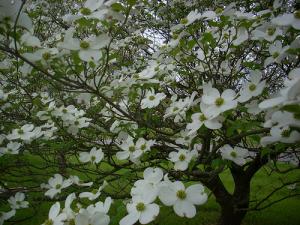Dogwood

In 1941 the North Carolina General Assembly designated the flower of the dogwood tree (Cornaceae) as the official state flower. In actuality, three species of dogwoods exist in North Carolina. The alternate-leaf dogwood (Cornus alternifolia), which is common in the mountains and rare in the northern piedmont, has leaves that are simple and elliptical but are alternate on their stems (hence the name). It has small white flowers that are in loose, flat-topped clusters. Various animals eat its small, deep-blue or black fruit; the plant is usually a shrub or a small tree up to 30 feet tall and eight inches in diameter with a broad, flattened crown.
The gray dogwood (Cornus racemosa) is a bush that has simple, elliptical, and opposite leaves. Its gray-to-white fruits and gray twigs give it its name. This dogwood grows in thickets in damp meadows in the mountains of the northwestern corner of North Carolina.
The flowering dogwood (Cornus florida), common in the wild and popular as an ornamental, is a tree that enchants people every spring. A relatively short tree, its four white (or sometimes pink) petal-like bracts circle the tiny greenish white flowers in the center. The bracts have dark indentations at their tips. The tree has simple, opposite, elliptical leaves that in fall turn from green to red to maroon, and its red berries are a favorite of birds. The flowering dogwood is found in deciduous woodlands throughout the state up to elevations of 4,500 feet.
In years past the hard, shock-resistant wood of dogwood trees was used to make farm implements, wedges for rail splitting, shuttles for spinning mills, tool handles, and other things. The bark, flowers, berries, and roots of the flowering dogwood also had many medicinal purposes. The bark and sometimes the roots were used as a substitute for Peruvian bark in treating intermittent fevers and malaria. The bark was also employed as an antiseptic and a cathartic. The flowers (not the bracts) made a good substitute for chamomile tea, and the berries, when soaked in brandy, also made a serviceable bitter.
Several legends surrounding the dogwood are still repeated in North Carolina. One popular story holds that 2,000 years ago the flowering dogwood tree stood straight, proud, and tall. Because the tree had such strong wood, the Roman soldiers under Pontius Pilate chose to make the cross of Jesus Christ out of dogwood trunks. The dogwood tree was horrified but had no choice. In order never to serve as a cross again, the dogwood became a slender, twisted tree. In addition, to help people remember Jesus' sacrifice, the dogwood flowers bloom in the spring in the shape of a cross with nail holes at the ends.